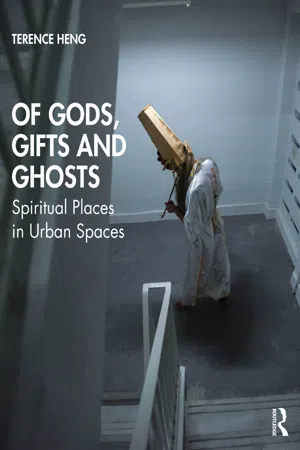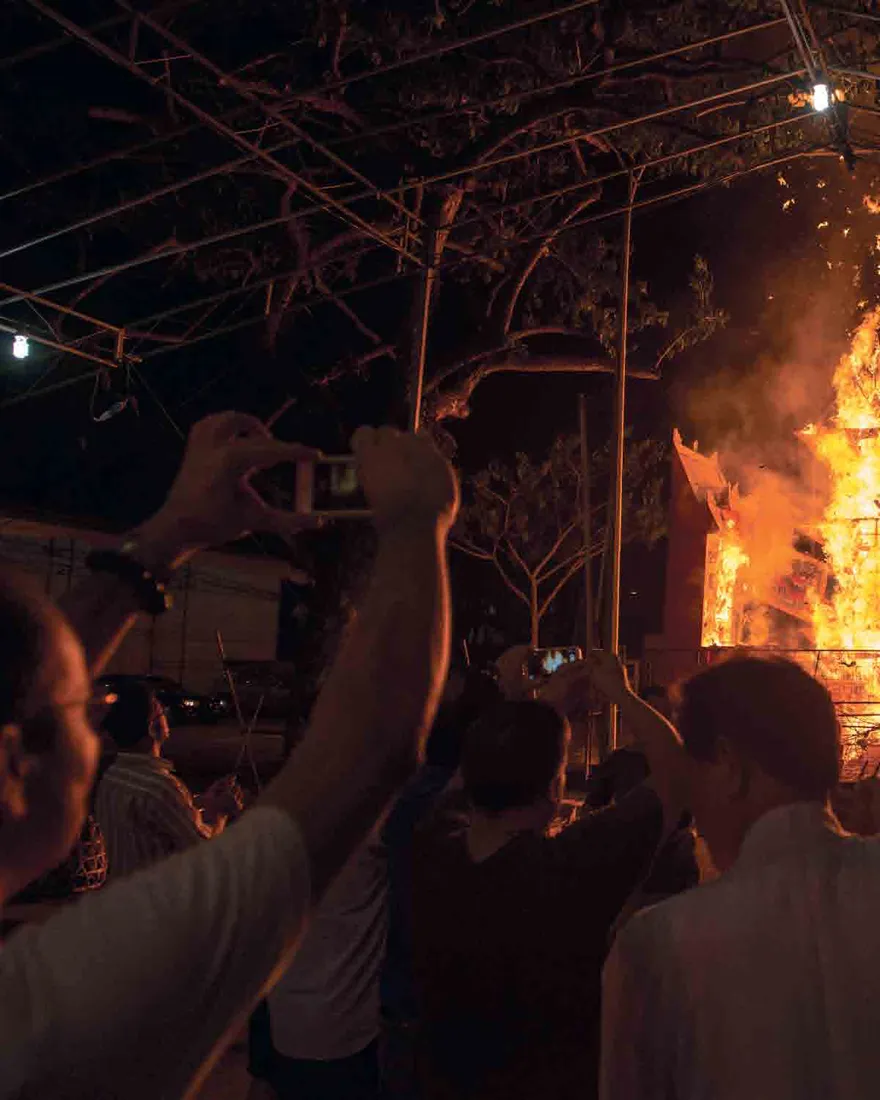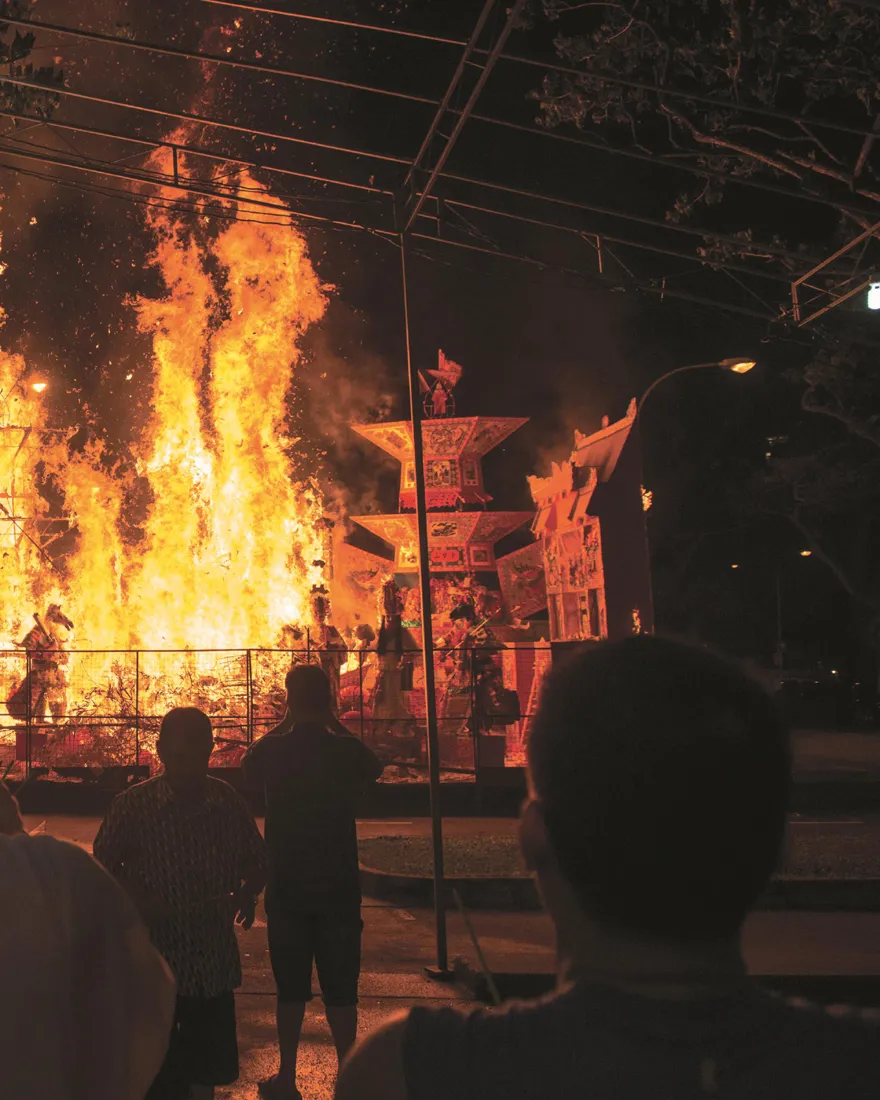![]()
1
Introduction
Introduction
The choice of the first image in this book is not, as one might think, simply because it shows the sheer spectatorship and performativity of Chinese religion rituals in Singapore (with an adherent in the foreground for scale). Indeed, the climax of many of these rituals involves setting highly flammable paper effigies of gods, possessions, servants and/or money alight – a means to transmogrify and hierophanise mundane objects into a spiritual reality, to be consumed mostly by gods, deities, ancestral spirits and ghosts both known and unknown. Scale becomes a proxy for social, economic and cultural capital of the devotees involved – the bigger the pile of things to burn, the greater the prestige, and perhaps the ensuing rewards from satiated ancestors.
Look closer, and you will notice that the effigies are constrained by a steel cage – a mundane appliance designed to keep the objects burning within a designated safe and legal space. Unlike other instances of burning in other countries, these rituals are often regulated by health, safety and environmental laws (except during some periods of the year) – religious fervour and social performativity are bounded, both literally and metaphorically by the state. At the same time, what the photograph does not show is that the ritual is taking place in an open-air carpark right next to Singapore’s Newton Hawker Centre – a food court made famous in tourist television commercials exported to the rest of the world. Newton Hawker Centre brings tourists to a safe, largely authentic, but still highly manufactured and contrived version of Singapore’s food cultures. The juxtaposition of the Hawker Centre to the burning effigies is a parable of many dialectic tensions of identity that permeate this nation-state – state/individual, “tradition”/modernity, local/global and much more.
This book is about visualising these dialectical tensions, bringing a sociological and geographical lens onto the practice of Chinese religion in Singapore, and its implications for the practice of sacredness, making of sacred space and forming and shaping of diasporic ethnic identities. Through the use of documentary photography, I will explore how the sacred and sacredness is manifested by individuals and groups in the unlikeliest of places, and how the exercise of such agency reveals the implications of making sacred space (Kong 1993) and performing ethnic identities in a nation-state of hypermodernity. This chapter introduces three important things about the book – one, I will provide a background and context of Chinese religion and the practice of Chinese religion in Singapore. Two, I will explore Singapore’s approach to managing space (especially religious space), ethnic identities and the relationship between the two. Three, I will explain the rationale for the book’s structure – because unlike other monographs, this volume seeks to put photographs at the centre of my analysis and presentation.
Chinese religion is not Chinese religion
“Chinese religion” is a complicated concept – what seems simple to identify on the surface (anything religious that is related to Chinese culture) gives way to a competing definitions, linguistics, spellings, forms of worship and scholarly attention (Adler 2007, Goh 2009, Goossaert 2005, Tan 2018). Goossaert and Palmer’s definition is the most useful here, where they note “Chinese religion” (in its late Qing Dynasty form) is
“… (a) system (of) integrated traditions of individual salvation, such as self-cultivation through meditation and body techniques, moral living, and spirit-possession techniques, including spirit writing; kinship-based rites, such as life-cycle rituals and ancestor worship; and communal religion, such as cults to local saints and deities – all of which were only partly framed within the three institutionalised teachings of Confucianism, Taoism, and Buddhism …. As Chinese religion does not have a single canon that could be a source of textual authority, there is no unified formal theology.”
(Goossaert and Palmer 2011:20)
Or, as Tan explains
“… Chinese popular religion is actually the complex of Chinese indigenous beliefs and practices that most ordinary Chinese observe in their daily and festive life, including honoring ancestors and worshipping gods and goddesses and even ghosts. Considered as religion in the anthropological sense, it is diffused, to use C. K. Yang’s term (citing Yang 1961:294); that is, like many religions outside the Islamic and Judeo-Christian traditions, it is part of people’s social life rather than forming a separate religious institution.”
(Tan 2018:4)
Chinese religion is also sometimes referred to as Chinese popular Religion (Tan 2018). However, Chinese religion and its variants are concepts that appear to be restricted to scholarly, and not quotidian use - none of my informants have ever claimed to be “Chinese religionists”, or state that their religion is “Chinese religion”. For example, Goossaert (2005:1613) points out that “Chinese popular religion is a scholarly construct which does not correspond to any traditional Chinese notion or institution … the fundamentally ambiguous word ‘popular’ sometimes refers to any widespread or commonly held idea or practice …”. Goossaert himself uses the term “Chinese religion” because it is accepted as a way to describe this myriad system of beliefs, largely because no one single term can encompass the multiple variants associated with it (see, e.g. Adler 2002, 2007, Mair et al 2005, Goossaert and Palmer 2011, Jansen 2012).
The groups and individuals I have worked with over the last seven years would be what many scholars consider to be part of the term “minjian zongjiao – which literally means ‘religion among the masses’” – sectarian groups that are numerous and influential enough to be considered an institution in themselves (Tan 2018). In Singapore, such a combination of beliefs is usually associated with the Zhengyi sect of Taoism, which combines folk religious beliefs with Taoist doctrine and practices (Adler 2007, Tan 2018). As such, my informants commonly refer to themselves as Taoist, and many Spirit Altar (sin tua or sheng tang – 神坛) organisations are registered with the Singapore Taoist Federation. One of my key informants, Nick, a tang-ki (乩童), or spirit medium, often lists one of his ambitions as spreading and raising awareness of Taoism.
It is not in the purview of this book to discuss the intricacies of how Chinese religion should be defined. Many scholars have spent tremendous amounts of time examining its history (Goossaert 2005) and have questioned its definition (Goh 2009), making it the de facto way to describe the phenomenon that I am studying. But I use the term “Chinese religion” with more than a little reluctance in this book – to do so removes at least some agency from my informants who refer to themselves as Taoist. But for the sake of simplicity, and also consistency with the literature, when I refer to practices as Chinese religion, I mean a Singaporean (and often South-east Asian) form of sectarian, spiritualist Taoism that encompasses liturgy from Taoist canon, deities from diasporic points of origin in China, and selective elements from Buddhism and other regional spiritualist practices (Taiwan being an increasingly popular source). Doing so helps to differentiate Chinese religion from institutional Buddhist and Taoist practices in Singapore.
In Singapore, scholars have examined Chinese religion from a variety of angles – most often so as a characteristic of Chinese or Diasporic Chinese cultures, everyday life, societies and/or history. Early studies of Chinese religion in Singapore include those by Topley (1955) who studied ghost marriages in Singapore, where families arranged for their deceased kin to be wedded, either to another deceased individual or to a living individual. In his study on Singaporean Chinese households, Freedman (1957) also included aspects of Chinese religion such as ancestral veneration, and the living’s relationships with the dead. Freedman’s study was also useful in mapping out makeshift temples and the positions of temporary altars in temple celebrations, which have continued to remain the same today. More recently, Tong (2004) explored contemporary death rituals in Singapore, examining themes of pollution, kinship, and cultural perspectives of different kinds of death – good, bad and violent. Chan (2006) is also often cited for her work on Chinese spirit mediums in Singapore, using a dramaturgical perspective to consider their role within society.
Many of these studies however ignore the sociological and (to a lesser extent) geographical insights that stand to be gained from analysing Chinese religion. More often than not, anthropological themes are heavily invoked (see, e.g. Cheu 1993, Wee 1976, DeBernardi 1984, 2004, 2012, Tong 2004), which significantly illuminate our understanding of the ritual, but do not place them within a sociological imagination. For example, how do we understand Chinese religion from a race/ethnicity perspective? In what ways is capital (Bourdieu 1986) gained through spirit possession? What is the role of the state in regulating practices that subvert its authority? In other words, much has been done in examining Chinese religion as a phenomenon unto itself, but more has to be said about what the practice of it means to the social lives of its adherents and the spaces in which these practices take place.
Even then, one of the difficulties I have encountered when writing about Chinese religion in Singapore is its opacity as a system of beliefs and practices to individuals (apart from scholars in anthropology and sociology). This opacity applies not just to audiences unfamiliar with religions from Asia (loosely defined), but also to individuals dwelling in Asia themselves. In Singapore, the practice of Chinese religion is gradually becoming dominated by the working-class, leading to a lack of meaningful engagement with the faith by policymakers, religious groups and to a lesser extent scholars (with some notable exceptions – see Chan 2006, Dean 2016, Goh 2009, Graham 2020, Lim 2019, Yang and Lang 2011). Chinese religion practitioners in Singapore are often derided or critiqued (especially by Evangelical/Protestant Christian adherents; see, e.g. Tong 2003) as superstitious and/or opposed to Judeo-Christian beliefs. Some of this is because of the visual culture of Chinese religion and the use of kim sin (idols) as part of the worship, the other because churches in Singapore have drawn much of their converts from this faith. For example, Clammer (1991) has looked at the parallels between Charismatic forms of Christianity and Chinese religion, and how their similarities have enabled easier conversions from the latter to the former. In secular circles, Chinese religion, especially Spirit Mediums and their assorted activities, are commonly viewed with suspicion, particularly by the state for their historical (and some would say current) connections with criminal activity and secret societies/triads.
To this extent, part of the reason for this book is not just to analyse the practice of Chinese religion as a sociological and geographical phenomenon, but also to attempt to demystify it in the eyes of the individuals who encounter it in the everyday. During certain parts of the year, Chinese religion rituals, such as the Hungry Ghost Festival, take up large swathes of space, both physical and social – becoming visible and reified, significant but still mysterious (even to its adherents). Despite efforts by both the state and civil society to engage in inter-religious dialogue, much of society remains fragmented along ethnic, class and religious lines, which in themselves interweave and overlap in complex ways. Other work on other religious practices in Singapore is also urgently needed for a better understanding and awareness of the multifaceted nature of faith. However, for now I intend to develop this book as a way to visualise what is often hidden in plain sight. In the next section, I will discuss the spaces and places where such rituals, activities and artefacts are situated, and the relationship between them and the regulatory state.
Sacred space and/vs state space
Sacred space (Kong 1993), as the term implies, is space in which the sacred is seen to have manifest, often through a process of hierophany (Eliade 1961). Sacred space is social, political and cultural – it is constructed through the actions and imaginations of individuals who inhabit and dwell in that space, thus also often associated with the act of place-making. Within the social sciences, sacred space appears to be most analysed in human geography – where discussions are wide-ranging on topic and scale, from looking at the politics of strategizing the making of sacred space to the everyday life and place-making activities of adherents and devotees (Chidester and Linenthal 1995, Tong and Kong 2000, Kong 2002, della Dora 2009, Holloway 2003, Woods 2013). In this section, I will consider three points that will help frame the rest of this book. One, sacred space is as imaginative as it is material. It is a thirdspace (Soja 1996), reified and made concrete in the minds of the individuals who inhabit the space, where such reification is done through tactile, emotional and sensorial means. Two, despite its ephemerality, sacred space is also highly visual. Three, because of said visuality, sacred space is both subversive and controlling – it is often a space of political contestation between groups, usually society and state, where individuals struggle in creating different and often contrasting forms of meaning. I argue that these characteristics lend themselves well to visual approaches. I will deal with each of them in turn.
Sacred space is imagination and materiality intertwined
In previous work (Heng 2015), I have argued that creating spiritual space is an act of place-making, in which the imagination of individuals was paramount in their reification of spirituality in physicality. Spiritual space was a form of what Soja (1996:67) would call secondspace – “the primary space of utopian thought and vision … the purely creative imagination some of artists and poets”. Laid over the planned and state-mandated maps that Soja also called firstspaces, we could see how a thirdspace – a reification of the imagination – could emerge. Likewise, with sacred space, the role of the imagination is important, as it allows for the subversion or workaround of physical structure and political restrictions so as to make a place useful for one’s faith. For example, Woods (2013) examined the use of ritual and prayer (and sacred networks) amongst Christian groups in Sri Lanka in the creation of house churches – alternative sacred spaces where fully visible and dedicated Church buildings were prevented by the state, while spiritualist churches in north-east England rely on a mix of belief, imagination and interpretation when establishing spaces in which the dead speak or communicate to the living through mediums (Bartolini, MacKian and Pile 2017).
Imagination can also be associated with believing in the presence of spiritual actors to aid in hierophany (Bartolini et al 2017), which are both sensed/felt and manifested, especially in deathscapes (what I would argue to be a subset of sacred space)....


